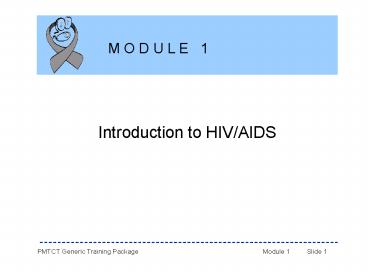PMTCT Generic Training PackageModule 1Slide 1 - PowerPoint PPT Presentation
1 / 28
Title:
PMTCT Generic Training PackageModule 1Slide 1
Description:
Describe the global and local impact of the epidemic. Answer basic questions about HIV ... Deteriorating child survival rates. Increasing numbers of orphans ... – PowerPoint PPT presentation
Number of Views:45
Avg rating:3.0/5.0
Title: PMTCT Generic Training PackageModule 1Slide 1
1
Introduction to HIV/AIDS
M O D U L E 1
2
Module 1 Objectives
- Describe the global and local impact of the
epidemic. - Answer basic questions about HIV/AIDS in women,
children, and families. - Discuss the natural history of HIV infection.
- Present information about HIV transmission.
3
Introduction to HIV/AIDS
- Session 1
- Scope of the HIV/AIDS Pandemic
4
Scope of the HIV/AIDS Pandemic
5
Scope of the HIV/AIDS Pandemic
- Global HIV/AIDS in 2003
- 40 million people are living with HIV/AIDS.
- 2.5 million are children under 15 years.
- 14,000 new infections each day
6
Impact of Global HIV
- Negative economic impact on countries
- Overwhelmed healthcare systems
- Decreasing life expectancy
- Deteriorating child survival rates
- Increasing numbers of orphans
7
National Epidemiology
- Insert national HIV/AIDS information.
8
National Epidemiology
- Insert national HIV/AIDS information on
- antenatal seroprevalence rates, MTCT.
9
National Epidemiology
- Insert national information on
- paediatric AIDS.
10
HIV and AIDS
11
HIV and AIDS
12
HIV and AIDS
- When the immune system becomes weakened by HIV,
the illness progresses to AIDS. - Some blood tests, symptoms or infections
indicate progression of HIV to AIDS.
13
HIV-1 and HIV-2
- HIV-1 and HIV-2
- Transmitted through the same routes
- Associated with similar opportunistic infections
- HIV-1 is more common worldwide.
- HIV-2 is found primarily in West Africa,
Mozambique and Angola.
14
HIV-1 and HIV-2
- Differences between HIV-1 and HIV-2
- HIV-2 is less easily transmitted.
- HIV-2 develops more slowly.
- MTCT is relatively rare with HIV-2.
15
Introduction to HIV/AIDS
- Session 2
- Natural History and Transmission of HIV
16
Natural History of HIV Infection
17
Natural History of HIV Infection
- HIV can be transmitted during each stage
- Seroconversion
- Infection with HIV, antibodies develop
- Asymptomatic
- No signs of HIV, immune system controls virus
production - Symptomatic
- Physical signs of HIV infection, some immune
suppression - AIDS
- Opportunistic infections, end-stage disease
18
Natural History of HIV Infection
- Severity of illness is determined by amount of
virus in the body (increasing viral load) and
the degree of immune suppression (decreasing CD4
counts). - Higher the viral load, the sooner immune
suppression occurs.
19
Natural History of HIV Infection
- Immune suppression
- HIV attacks white blood cells, called CD4 cells,
that protect body from illness. - Over time, the bodys ability to fight common
infections is lost. - Opportunistic infections occur.
20
Natural History of HIV Infection
- Direct infection of organ systems
- Brain (HIV dementia)
- Gut (wasting)
- Heart (cardiomyopathy)
21
HIV-Related Opportunistic Infections
22
Progression of HIV Infection
- HIGH viral load (number of copies of HIV in the
blood) - LOW CD4 count (type of white blood cell)
- Increasing clinical symptoms (such as
opportunistic infections)
23
Natural History of HIV InfectionSummary
- HIV multiplies inside the CD4 cells, destroying
them. - As CD4 cell count decreases and viral load
increases, the immune defences are weakened. - People infected with HIV become vulnerable to
opportunistic infections. - HIV is a chronic viral infection with no known
cure. - Without ARV treatment, HIV progresses to
symptomatic disease and AIDS.
24
Transmission of HIV
- HIV is transmitted by
- Direct contact with infected blood
- Sexual contact oral, anal or vaginal
- Direct contact with semen or vaginal andcervical
secretions - Mothers infected with HIV to infants
duringpregnancy, delivery and breastfeeding
25
Transmission of HIV
HIV cannot be transmitted by
- Coughing, sneezing
- Insect bites
- Touching, hugging
- Water, food
- Kissing
- Public baths
- Handshakes
- Work or school contact
- Using telephones
- Sharing cups, glasses, plates, or other utensils
26
Prevention of HIV Transmission
- Public health strategies to prevent HIV
transmission - Screen all blood and blood products.
- Follow universal precautions.
- Educate in safer sex practises.
- Identify and treat STIs.
- Provide referral for treatment of drug
dependence. - Apply the comprehensive PMTCT approach to prevent
perinatal transmission of HIV.
27
Module 1 Key Points
- HIV is a global pandemic.
- The number of people living with HIV worldwide
continues to increase. - The HIV epidemic is especially severe in many
resource-constrained countries. - HIV is a virus that destroys the immune system,
leading to opportunistic infections. - The progression from initial infection with HIV
to end-stage AIDS varies from person to person
and can take more than 15 years.
28
Module 1 Key Points
- The most common route of HIV transmission
worldwide is heterosexual transmission. - Women of childbearing age are at particular risk
for acquiring HIV. The main behaviour that places
them at risk is unprotected sex with an infected
male partner. - Pregnant women who are HIV-infected are at risk
of passing HIV infection to their newborn. - Risk of HIV transmission from mother-to-child can
be greatly reduced through effective PMTCT
programmes.































